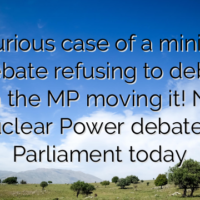Extract from full article http://tx1.fcomet.com/~claverto/cms/download/316/
See also http://tx1.fcomet.com/~claverto/cms/download/314/
(This technically numerate, evidence based article, shows that wind does not need any extra back up when it is not windy, due to the blindingly obvious fact that the existing power stations can simply be started – no new ones have to be built. Why this obvious fact escapes other commentators remains a mystery.
Millborrow shows that the extra costs of spinning reserve to cope with the greater variability of wind power is around a mere £7.6/MWh, with 40% wind and no capacity credit, or £5.8/MWh without. ie 0.76p/kWh – 0.58p/kWh.)
Editorial introduction: The UK has committed itself to a very ambitious target to increase its wind powered generation capacity by 2020. The EC’s 15% renewable energy target implies that renewable electricity, much of its wind power, will have to provide between 35-40% of electricity supplies. This has caused concerns in some quarters that the UK ‘s security of supply will be placed in jeopardy. However, others say this concern is overplayed. In the following article, David Milborrow* debunks myths surrounding wind power’s reliability:
Extract from full article http://tx1.fcomet.com/~claverto/cms/download/316/
See also http://tx1.fcomet.com/~claverto/cms/download/314/



The bigger question is wha to do with wind energy at times of off-peak demand.
The answer must be storage. The classic is pumped storage. ‘Ripple Control’ aka ‘smart metering’ can store off-peak energy as heat (or cold) at the consumer.
ITM Power offer hydrogen storage there. They reason that the wires are dimensioned to cope with peak demand all the way to the 13 A socket. (Actually there is some averaging on the ring main and as you get further from the consumer.)
Therefore hydrogen could be generated at the consumer much of the time making it possible to use the available wind energy nearly all the time, thereby saving fuel.
It might be even more cost effective to generate the hydrogen at the windfarm because according to Ing Tetzlaff the cost of electrical infrastructure is at least 10x that of gas.
Tend to agree with you.
Pumped storage is pretty useless though, as it is very expensive and Dinorwig can only deliver about 2 GW for about 4 hours or so no good at all for long term storage, or long term excess.
Quite agree electrolysis to hydrogen is one option, but hydrogen is a quite useless vehicle fuel due to the inability to get enough of the stuff into a vehicle.
http://tx1.fcomet.com/~claverto/cms/download/167/
http://tx1.fcomet.com/~claverto/cms/download/159/
Much better to use ammonia, which is not, as ill informed people suppose, any more dangerous to transport than petrol, and can be readily used in existing engines, and you can get enough of the stuff into vehicles.
Batteries are of course another option and twice as efficient as either hudrogen or ammonia, but don’t yet exist with sufficient range or cheapness, and have huge environmental impacts – like where are you going to get all the lithium from?
Much better to go to electric trains, and electricity trams which can use the stuff directly, and travel at 70 mph (in 1935) with overhead pole pick up.
Have you got any articles we can publish?
I hope you do not mind but I have tried to post (not sure if I have been successful) the attached on the Claverton web site.
It is a commentary on your article “Is wind reliable”
Please feel free to rubbish what I say
Regards
Denis Stephens
………………………..
Dennis –
I’ve loaded this article into the file area ( I wish others would learn how to do this and help me out by the way)
http://tx1.fcomet.com/~claverto/cms/download/319/
(You can look at all the wind files by going to LIBRARY / DOWNLOADING FILES and clicking on wind)
I’ve then put the link as a comkment on the main article by David M
Best
Admin
[…] contrasting views on this topic, you can read these two articles: Wind is reliable and Critique of wind integration into the grid on […]
i have not found the information im looking for so im going to find another site bye.
It is a question of how to utilise fully the electricity generated by an intermittent and unpredictable supply…… generating hydrogen via water electrolysis is a very good way of storing energy for long periods of time…. it is a fuel that can be used as and when required, and allows the power industry the opportunity to make a clean transport fuel with surplus electricity at off peak times.
See what Quentin Willson thinks, at the recent launch of ITM Power’s Hydrogen On Site Trial (HOST)….
http://www.youtube.com/user/ITMPowerPlc#p/a/u/0/joviBoPHuGM
A year long trial with 21 commercial logisitics companies representing 7 sectors…. making a fuel where it is needed, at the point of use, so eliminating the carbon footprint of delivered fuel, the fuel production (if renewable energy used) and the carbon emissions of vehicles.
[…] contrasting views on this topic, you can read these two articles: Wind is reliable and Critique of wind integration into the grid on Claverton. The reality here is that the service […]
[…] http://tx1.fcomet.com/~claverto/cms/is-wind-power-reliable-an-authoritative-article-from-david-millborro… […]